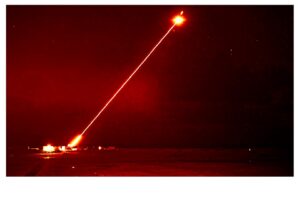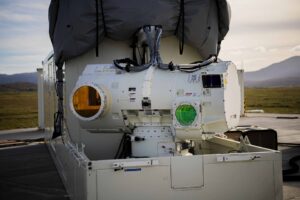The U.K. recently tested its DragonFire laser directed energy weapon (LDEW) against aerial targets in a high power firing, a first for the system.
The DragonFire engaged the targets at the U.K. Ministry of Defense’s (MoD) Hebrides Range in this project milestone, the government said on January 19.

While the government and industrial partners did not disclose specifics, they said the aerial targets were hit at “relevant ranges” and representative altitudes and speeds.
The MoD underscored this is potentially a “long-term low-cost alternative to certain tasks missiles currently carry out” as an operating cost of typically under $13 per shot.
“Firing it for 10 seconds is the cost equivalent of using a regular heater for just an hour,” the ministry said.
MoD’s Defence Science and Technology Laboratory (Dstl) leads the DragonFire project, working with industry partners MBDA, Leonardo and QinetiQ.
“The DragonFire trials at the Hebrides demonstrated that our world-leading technology can track and engage high-end effects at range. In a world of evolving threats we know that our focus must be on getting capability to the warfighter and we will look to accelerate this next phase of activity,” Shimon Fhima, Director Strategic Programmes for the MoD, said in a statement.
The aerial target trials follow earlier successful events including the first static high-power laser firing on a U.K.-based laser system and a demonstration of DragonFire’s ability to track moving air and sea targets at long range.
In 2022, Dstl hosted the first LDEW trial at several undisclosed targets on ranges at Porton Down with “pinpoint accuracy from the beam director.
The government said both the British Army and Royal navy are considering using the DragonFire technology in future air defense capabilities.

“This type of cutting-edge weaponry has the potential to revolutionize the battlespace by reducing the reliance on expensive ammunition, while also lowering the risk of collateral damage. Investments with industry partners in advanced technologies like DragonFire are crucial in a highly contested world, helping us maintain the battle-winning edge and keep the nation safe,” British Defense Secretary Grant Sapp said in a statement.
DragonFire is the product of a $127 million joint investment by the MoD and industry.
Previously, in 2017 the MoD awarded an MBDA-led group a 30 million British pounds, then worth $37.5 million, contract to demonstrate the 50 kilowatt LDEW demonstrator (Defense Daily, Jan. 23, 2017).
At the time, MoD said the system was designed to pick up and track targets at various ranges in mixed weather conditions over both land and water. It is meant to also inform future program decisions and help Dstl establish a road map to in-service capability. The ministry had also said if the project was successful, DragonFire-type laser weapons could come into service in the mid 2020s.
MBDA has overall responsibility for DragonFire and developed the advanced command and control and image processing capabilities, Leonardo developed the beam director that tracks and points at targets accurately and QinetiQ built the 50 kW phase-combined laser.